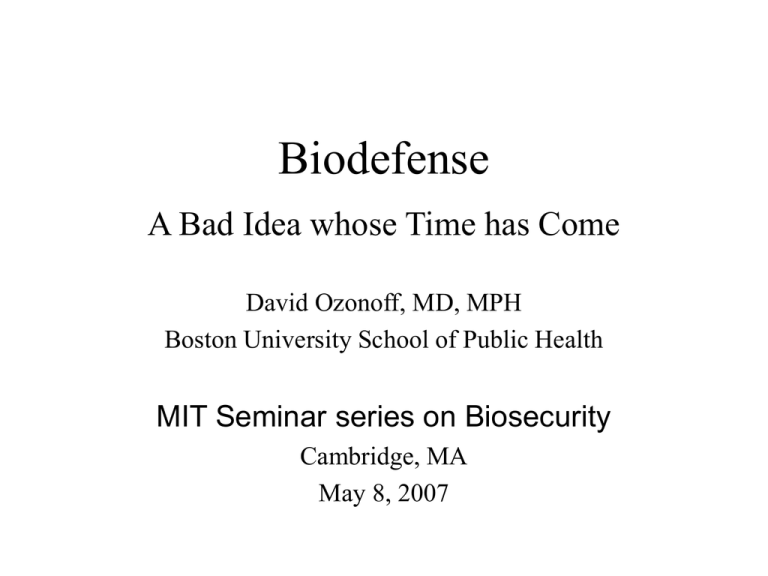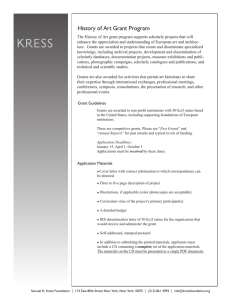Click here for Professor Ozonoff's powerpoint slides from this talk.
advertisement

Biodefense A Bad Idea whose Time has Come David Ozonoff, MD, MPH Boston University School of Public Health MIT Seminar series on Biosecurity Cambridge, MA May 8, 2007 BU Biolab • Context – National Security State – Provides the justification for all things when things need justification, whether they make sense or not • Historically contingent construction so entangled with ideology, politics and real concerns as to be impenetrable to argument Why is “biodefense” a bad idea for public health? Let me count the ways . . . • • • • • • Distortion of priorities Distortion of public health style Less safe, not more safe Specter of classified research No true civilian oversight Arms control issues Distortion of priorities • Within microbiology – Open letter to Zerhouni by 758 microbiologists tularemia: average US cases/year: 122 average US deaths/year: 0 anthrax: average US cases/year: 3* (includes 22 bioterrorismrelated cases in 2001) average US deaths/year: 1* (includes 5 bioterrorismrelated deaths in 2001) plague: average US cases/year: 5 average US deaths/year: 0 glanders: average US cases/year: 0 average US deaths/year: 0 melioidosis: average US cases/year: 0 average US deaths/year: 0 brucellosis: average US cases/year: 103 average US deaths/year: 0 For comparison, US cases/year for diseases caused by other pathogenic microorganisms are as follows [data for 1996-2003; sources as above]: tuberculosis: 17,403 syphilis: 38,007 gonorrhea: 346,765 salmonellosis: 42,457 pertussis: 8,252 chlamydia: 685,508 meningococcal infection: 2,290 shigellosis: 22,567 streptococcal infection, invasive: 4,371 streptococcal infection, invasive, drug-resistant S. pneumoniae: 3,083 borreliosis: 17,642 legionellosis: 1,334 ehrlichiosis: 591 Increase in number of grants for research on prioritized bioweapons agents [http://crisp.cit.nih.gov/] number of new and competing-continuation grants awarded under NIAID and referencing agents that cause tularemia, anthrax, plague, glanders, melioidosis, and brucellosis (Francisella tularensis, Bacillus anthracis, Yersinia pestis, Burkholderia mallei, Burkholderia pseudomallei, Brucella melitensis) 1996-2000: 33 2001-Jan 2005: 497 (133 in Jan 2005) change: 1500% increase number of new and competing-continuation grants awarded under NIAID and referencing agent that causes tularemia 1996-2000: 3 2001-Jan 2005: 93 (19 in Jan of 2005) change: 3100% increase number of new and competing-continuation grants awarded under NIAID and referencing agent that causes anthrax 1996-2000: 7 2001-Jan 2005: 243 (76 in Jan 2005) change: 3500% increase number of new and competing-continuation grants awarded under NIAID and referencing agent that causes plague 19962000: 22 2001-Jan 2005: 129 (31 in Jan 2005) change: 590% increase number of new and competing-continuation grants awarded under NIAID and referencing agent that causes glanders 1996-2000: 1 2001-Jan 2005: 10 (3 in Jan 2005) change: 1000% increase Decrease in number of grants for research on nonbiodefense-related microbial physiology, genetics, and pathogenesis [http://crisp.cit.nih.gov/] number of new and competing-continuation grants awarded under Microbial Physiology and Genetics Initial Review Group (MBC1, MBC2) 1996-2000: 490 2001-Jan 2005: 289 change: 41% decrease number of new and competing-continuation grants awarded under Bacteriology and Mycology Initial Review Group (BM1, BM2) 1996-2000: 627 2001-Jan 2005: 457 change: 27% decrease Distortion of other public health priorities • Effects on federal health attention and resources: influenza A/H2N2 • Wholesale rearrangement of personnel assignments related to state and local budget cuts coupled with new BT money • “Leaf-raking,” hypertrophy and atrophy Public health “style” • Horizontal to vertical – Committee versus incident commander – Becoming an arm of public safety • Military mindset and vocabulary – Talking the talk to get in the game – Using “national security” as lever • Formerly: When public health works, nothing happens – Now, Nothing works until something happens Less safe, not more safe • Soft targets and available weapons • Novel pathogens are unavailable unless . . . • Two many laboratories and the human element • Bringing public health to its knees (white powder syndrome) Classified and secret research • Inevitable consequence of this orientation • Does not serve a legitimate scientific or public health agenda • Doesn’t permit oversight Lack of civilian oversight • Violation of safety standards • Violation of community standards of science and public health – “Scientific pornography” Effect on biological arms race • Has potential to stimulate an arms race • Ultimate consequences unknown but downside extremely bad
